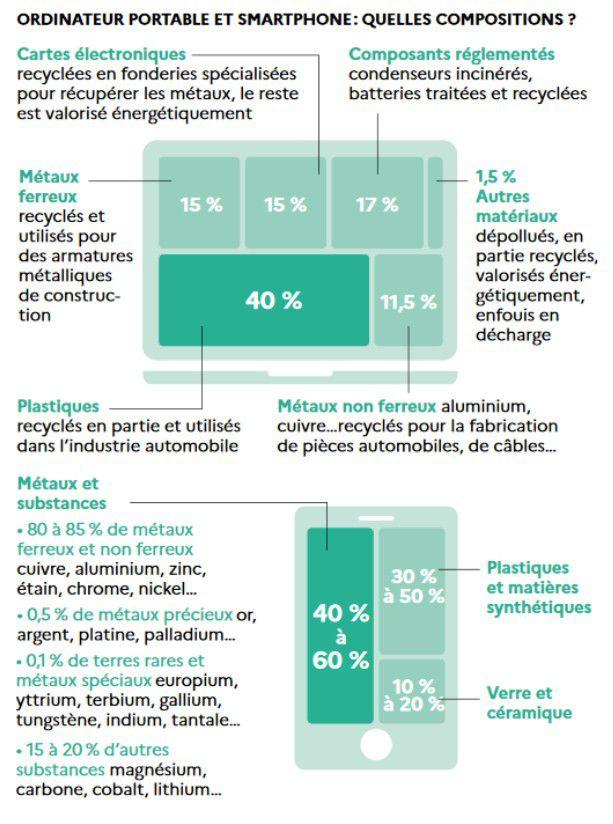Often perceived as positive because it creates jobs, growth and new economic models, digital technology is responsible for 3.5% of global greenhouse gas emissions. The sharp increase in our uses suggests a doubling of this carbon footprint by 2025. And in this field, France is far from being a model: a French citizen has on average 15 connected devices, a figure well above the world average which is 8.
However, a digital device has significant ecological impacts throughout its lifespan: from its manufacture to its end of life (10 million tonnes of waste per year) through its use (10% of French electricity consumption and 2. 5% of its carbon footprint). This is the observation made by the government agency for ecological transition (Ademe) in two unpublished studies carried out with Arcep, the French telecoms policeman, published on Wednesday January 19.
OK it's alarming, but how can we change our behavior in front of screens? There are about fifteen gestures identified by the two agencies to “move towards digital sobriety”. The problem: the French have only adopted four today... But don't panic and follow the guide!
1. Buy refurbished, not new
By avoiding the energy-intensive phases of material production, refurbished smartphones are on average eight times more virtuous than new ones from an environmental impact point of view, according to Ademe. If the market for refurbished smartphones has grown strongly in recent years: more than a third of French people have now bought a second-hand smartphone, but 82% still plan to buy new, their next phone.
To dissuade them, Ademe suggests looking in detail at how your smartphone will be produced: 80 to 85% ferrous and non-ferrous metals (copper, aluminium, zinc, etc.), 0.5% precious metals ( gold, silver, platinum, etc.), 0.1% of rare earths and metals (europium, terbium, gallium, etc.) and 15 to 20% of other substances such as magnesium, carbon, cobalt, lithium , etc.).

In 2020, with sales estimated at 2.8 million units, the use of refurbished smartphones by the French allows savings of approximately 229,000 tonnes of raw materials and 70,000 tonnes of CO2 equivalent, according to the study by the ADEME.
2. Choosing the right refurbished products
Now that you are convinced of the benefits of reuse, let's move on to the phase of "maximizing the positive environmental effects of refurbishing smartphones". Ademe recommends a few best practices for this:
- Favor products from local repackaging in short circuit;
- Do not choose products that have entered the market too recently so as not to encourage a refurbished market based on overconsumption;
- Choose older equipment to be in a real dynamic of circular economy and second life;
- Keep your refurbished mobile for as long as possible;
- Only purchase accessories when necessary.
3. Use: adopt new reflexes
Smartphone:
1/ Save your battery and recycle your phone at a dedicated collection point.
2/ Favor Wifi over 4G so as not to saturate the antennas, reduce the resolution of videos on devices that do not allow HD to be appreciated.
Computer :
1/ Turn off your computer when you're not using it, repair rather than buy.
2/Favor audio over video and size your purchase according to your needs.
TV: Disable automatic video playback and turn off your box and TV.
Connected objects: Deactivate your objects when you are not using them, buy according to your needs and resell or give away your device that you no longer use.
Streaming: Choose audio over video to listen to music.
Cloud: Sort and avoid automatically transferring data to the cloud.
Mail: Unsubscribe from newsletters that are not read and limit the sending of heavy attachments.
Extend the duration of use, recycle smartphones: Resell or give away smartphones, or bring them back to a dedicated collection point if they are out of order.
That's it, you know everything, there's more than...
You can find all the data here: the studies “Reusing and reusing” and “Buying a refurbished smartphone, what are the advantages? », the guide « On the way to digital sobriety » and the Barometer of new technologies, 2021 edition.
Digital and pollution: the numbers
Electricity consumption for digital services in France is estimated at 48.7 TWh, or 10% of French electricity consumption, the equivalent of the annual consumption of 8,282,000 French households.
62.5 million tons of resources (MIPS4) are used per year to produce and use digital equipment.
The environmental impact of annual digital usage per capita is equivalent to driving 2,259 km.
Waste production is equal to 299 kg/inhabitant over the entire life cycle of equipment (from manufacture to end of life).
The mass of materials moved during the manufacturing phase is equal to 932 kg/inhabitant.
Medical deserts, public services: what assessment of Macron on rurality?
What is the best Oppo smartphone to choose?
The best phones in 2021 for photos and video
Good Plan: the recap of 4G packages on sale